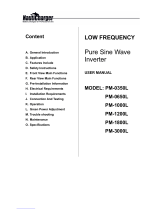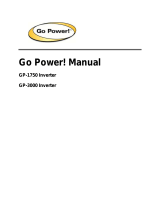
Part No. 90-0113-00
Fdmman2.p65 2/98
BATTERY CHARGING
Addendum, pages 28-34. If you equalize
using a Link Instrument, refer to the Link
Owner’s Manual for more information.
For more information and precautions,
check the battery manufacturer specifications
and recommendations. Additional information
on equalizing is also available on our Web
site http://www.heartinterface.com.
Charging Over-Discharged Batteries
Charging a battery bank with a terminal
voltage of less than 8 Volts presents a special
problem for the unit. If this situation arises, the
unit will attempt to charge for 1 minute. If the
charger senses excessive ripple voltage, it will
shut down to protect itself.
To successfully charge an over-
discharged battery, you must remove as
much DC load as possible and set Power
Sharing to the lowest setting. Refer to the
Freedom Remote Control Panel Addendum
pages 28-34 and Link Owner’s Manual for
more information.
When charging completely dead
batteries, it is helpful to recharge them at
lower current levels. To accomplish this, use
the Power Sharing feature to reduce the
charge current until the battery voltage
reaches a normal level.
For battery voltage settings, refer to the
Battery Charger Voltage Settings chart on
page 17.
15
The equalizing charge is a timed, 8-hour
cycle. If desired, it can be ended by inter-
rupting the AC power to the charger at any
time during the cycle. Equalizing should only
be engaged after the batteries have been fully
charged by a normal battery charging cycle.
During this charge cycle, the battery
voltage will increase to the equalize voltage.
This will cause the battery bank to gas
profusely and will accomplish the following:
1. Removal of residual sulfate. Each time a
battery is cycled (discharged and recharged),
a small amount of sulfate is left on the plates.
Over time, this gradual build-up of sulfate will
compromise the performance of the battery.
By applying an equalizing charge, the sulfate
is returned back to the electrolyte, raising the
specific gravity and fully exposing the active
material of the plates.
2. Bring all cells to the same potential. All
lead-acid batteries are made up of individual
2 Volt cells. As the battery bank is cycled,
slight differences in the cells result in different
cell voltages, affecting the overall charge
effectiveness. Equalizing brings all cells up to
the same voltage and the electrolyte in each
cell to the same specific gravity.
3. Mixing up of the electrolyte. Electrolyte in
battery cells tend to separate into layers of
acid and water. The vigorous bubbling action
of the battery during equalizing serves to
physically mix the electrolyte.
Equalizing is not required on gel cell
batteries. For more information on equalizing
using the Freedom Remote Control Panel,
refer to the Freedom Remote Control Panel































